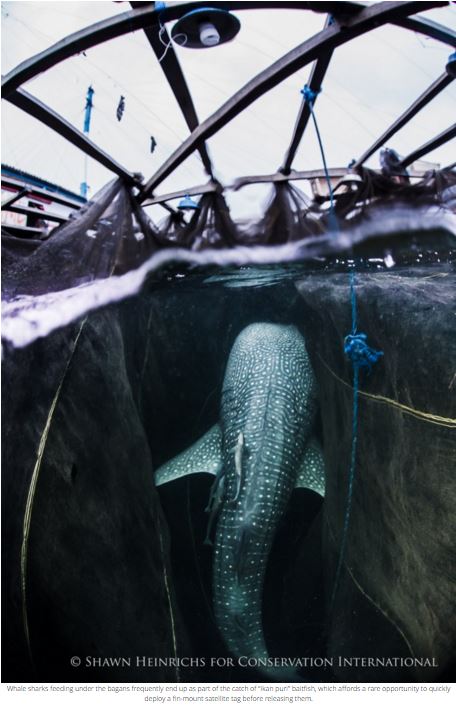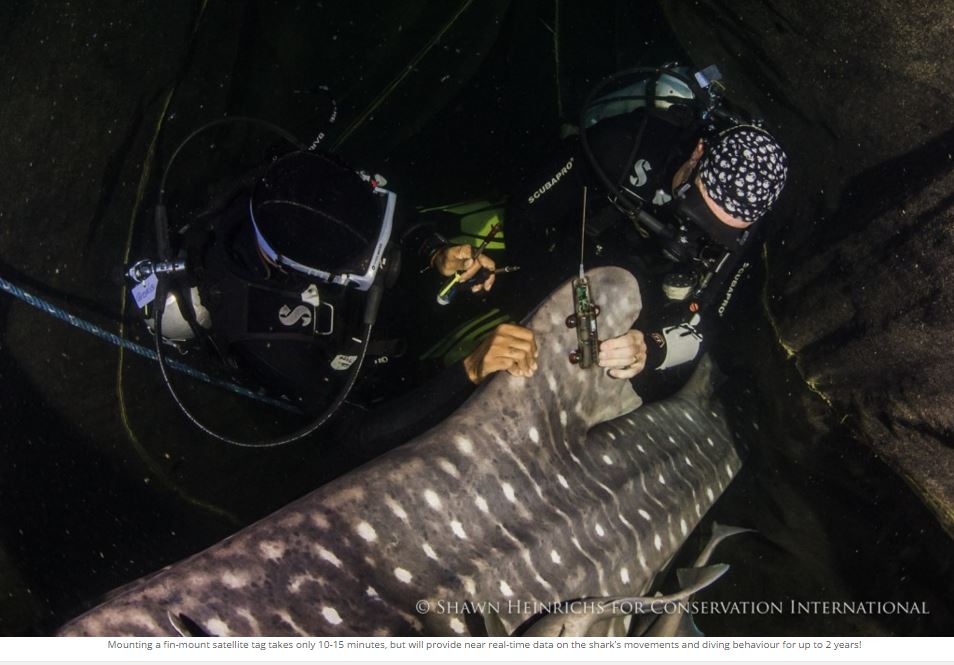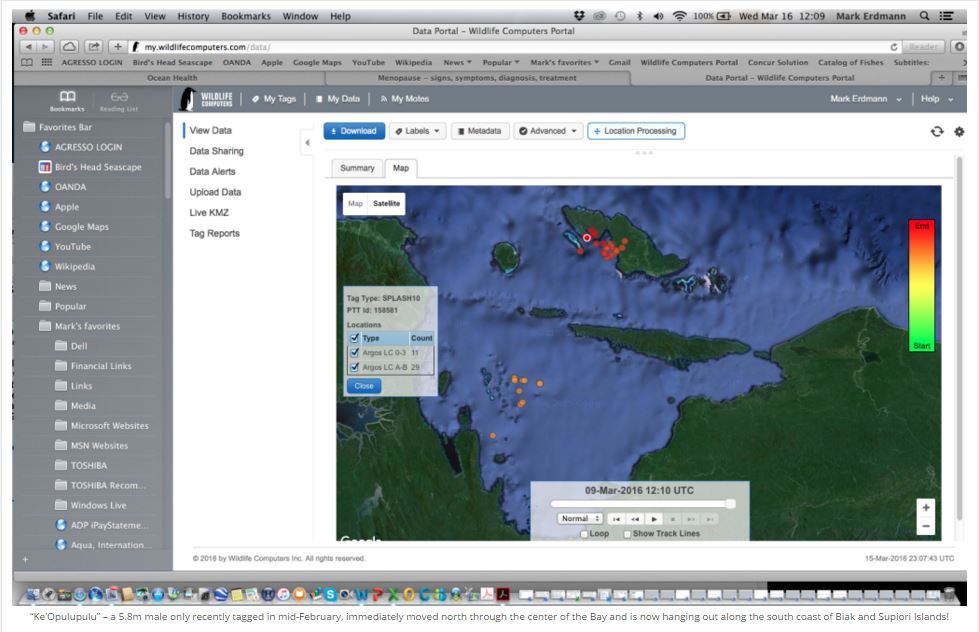Marine Life & Conservation
Cendrawasih’s whale sharks…. not such homebodies after all

For the past five years, Cendrawasih Bay’s friendly whale shark population has been attracting a lot of attention, primarily because of the near-certainty of having outstanding (and lengthy!) whale shark encounters during a visit to the region. Unlike many of the other known whale shark aggregations in the world (such as Ningaloo, Isla Mujeres, Belize, Galapagos and Donsol), which are highly seasonal, we now know with certainty that Cendrawasih has whale sharks present in the bay year round. Indeed, based on our observations combined with photos submitted by visitors to our BHS whale shark database, some highly-recognizeable individuals seem to be present throughout the year. Of course, one of the surest ways to confirm this is to monitor individual animals’ movements through satellite tagging – which is exactly what we’ve been doing in collaboration with the Cendrawasih Bay National Park Authority and Pak Bram Maruanaya and his local Kalilemon homestay in Kwatisore.
 Since June 2015, we’ve been able to tag 15 male whale sharks (ranging in size from 3 to 7 m in length) from Cendrawasih, using custom-made fin-mounted satellite tags by Wildlife Computers. These fin-mount tags have extended battery life which we hope will provide data for up to two years, and we’ve been delighted with their performance to date. All but one of the tags has been transmitting data very regularly (on average every 2-5 days) – basically each time one of the tagged sharks spends enough time on the surface for the tag to uplink to the ARGOS satellite network.
Since June 2015, we’ve been able to tag 15 male whale sharks (ranging in size from 3 to 7 m in length) from Cendrawasih, using custom-made fin-mounted satellite tags by Wildlife Computers. These fin-mount tags have extended battery life which we hope will provide data for up to two years, and we’ve been delighted with their performance to date. All but one of the tags has been transmitting data very regularly (on average every 2-5 days) – basically each time one of the tagged sharks spends enough time on the surface for the tag to uplink to the ARGOS satellite network.
As previously reported back in November, the initial data received from June through October 2015 seemed to confirm what many suspected – that Cendrawasih whale sharks are largely “homebodies”, preferring to stay close to shore and feed upon the abundant ikan puri baitfish schools that abound in the coastal bays and estuarine areas of the southern and eastern coastlines of Cendrawasih. Which of course is a great thing for BHS marine tourism, as it means visitors can pretty much plan a trip any time of the year and have a very good chance of excellent whale shark interactions.
By December, however, we started to observe some very different behaviours that indicate Cendrawasih’s whale sharks might not be such homebodies after all! Just before Christmas, four of the sharks almost simultaneously moved towards the small exit to the bay between the eastern tip of Yapen Island and the Papuan mainland. Though two soon turned back, both “Jude” and “Wally” proceeded down the coastline towards Jayapura. Jude eventually turned back and returned to Kwatisore, but Wally continued down the coast – becoming the first of our tagged sharks to become an international visitor when he crossed into PNG waters in early January. While he appeared at one point to be returning to Cendrawasih (making it as far west as Jayapura), he’s since returned to the Wewak region of PNG (near the Sepik River outlet) and seems to be happily enjoying an extended vacation there!
Similarly, one of our most recently tagged whale sharks, Ke’Opulupulu, headed almost immediately north into the center of the Bay (near the Auri Islands and atolls), then navigated to the south coast of Biak and Supiori Islands, where he’s remained for the past few weeks.
But horizontal movements are only part of the excitement we’ve recently recorded. The past 3 months have also seen a dramatic increase in deep-diving behaviour of many of our tagged sharks. While we did previously report a 672m deep diving record in October, we’ve now seen four of our sharks venture below 1000m depth, with the aptly-named “Moby” smashing the depth record (but fortunately not his tag’s depth gauge!) at 1416m!!! Even the “wee” 3m “Fijubeca” has dived to 700m depth. It’s still not clear why the sharks have shown such deep diving behaviour over the past few months – perhaps the El-Nino warmed surface waters are not providing enough food and they are searching for deeper plankton…
Overall, we’re delighted to see these fin-mount tags proving so successful at divulging some of the secrets of Cendrawasih’s whale sharks. Its particularly noteworthy that the first 5 months’ of data seemed to simply confirm our scattered direct observations, but the past 4 months have revealed numerous exciting behaviours we didn’t expect. Who knows what the next few months’ data might reveal? Stay tuned and we’ll happily report back as the data keeps flowing in. And please remember – you too can contribute to our expanding knowledge and understanding of the charismatic megafauna of the Bird’s Head by contributing your photo IDs and observations of whale sharks and manta rays in the region to the databases maintained by our site.
Mark Erdmann is Conservation International’s Vice President of Asia Pacific Marine Programs. Though now based in New Zealand after 23 years in Indonesia, he is still intimately involved with the Bird’s Head Seascape and frequently disappears into its remote corners for weeks on end….
Shawn Heinrichs is an Emmy Award-winning cinematographer, photographer and marine conservationist. An independent filmmaker, he is the founder of Blue Sphere Media, a production company specializing in underwater, adventure and conservation media. His work was recently featured in the film Racing Extinction.
A special thanks to Audrey, Shannon and Dennis Wong, Sally Timpson, and the management and guests of the True North expedition vessel for generously sponsoring the fin-mount whale shark satellite tags reported here, to Patti Seery and her amazing staff and crew of the Si Datu Buah liveaboard for hosting our most recent deployment expedition, and to OceanMax for continuing to support the tagging program with PropSpeed silicone foul-release coating for our satellite tags.
Marine Life & Conservation
Paul Watson Released as Denmark Blocks Japan’s Extradition Bid

Renowned anti-whaling activist Paul Watson has been released from custody in Greenland after spending five months in detention. Denmark’s Justice Ministry rejected Japan’s request for his extradition, citing insufficient guarantees that his time already served in custody would be credited against any potential sentence.
The 74-year-old Canadian-American was arrested on July 21 in Nuuk, Greenland’s capital, when his ship docked to refuel. His arrest was based on a 2012 Japanese warrant related to a 2010 encounter in Antarctic waters. Japan alleged Watson obstructed operations and caused damage to a whaling research ship during efforts to disrupt illegal whaling. Watson has consistently denied these claims, maintaining his commitment to marine conservation.
Denmark, which oversees extradition matters for Greenland, concluded that while the legal conditions for extradition were met, the lack of assurances from Japan regarding time-served credit made extradition untenable.
In a video shared by his foundation, Watson expressed gratitude and relief, saying, “After five months, it’s good to be out… and good to know they’re not sending me to Japan.” He added that the most difficult part of his time in custody was being separated from his two young sons.
Watson is a pioneering figure in marine conservation, known for founding the Captain Paul Watson Foundation in 2022 after decades of activism with the Sea Shepherd Conservation Society. His bold efforts to defend marine life have earned him widespread support, including from celebrities and conservationists. His work has also been featured in the acclaimed reality TV series Whale Wars.
Watson’s lawyer, Jonas Christoffersen, praised the decision, stating, “We are happy and relieved that Paul Watson is now free.” He added that Watson is eager to reunite with his family and continue his vital work.
The arrest occurred while Watson’s vessel, the M/Y John Paul DeJoria, was en route to the North Pacific with a team of 26 volunteers to intercept a Japanese whaling ship. His foundation described the arrest as politically motivated and emphasized that Watson’s actions were focused on ending illegal whaling practices.
Japan resumed commercial whaling in 2019 after leaving the International Whaling Commission, asserting that whale meat is a cultural tradition. Conservationists, however, continue to challenge these practices, highlighting their impact on marine ecosystems.
Despite the challenges, Watson remains steadfast in his mission to protect marine life and bring attention to whaling practices. His dedication to ocean conservation has made him a globally respected advocate for the environment.
Marine Life & Conservation
12 Days of Zero-Waste Fish-mas

This holiday period, the Marine Conservation Society, the UK’s leading ocean membership charity, invites you to make some simple changes to eating fish this Christmas to help our seas.
Dr Kenneth Bodles, Head of Fisheries and Aquaculture at the Marine Conservation Society, said, “During the festive season, our consumption increases, but so does waste. Sustainability isn’t just about where food comes from – it’s also about how you use it. By reducing waste and making the most out of your seafood, you’re not only taking steps to be more ocean-friendly, but can also help to cut costs during what is often one of the most expensive times of the year”.
The Marine Conservation Society has compiled twelve tips on how to consume seafood sustainably with zero-waste this Christmas:
Buy whole fish instead of fillets
Instead of fillets, consider buying whole fish such as salmon, hake, or lemon sole. By adopting a “nose to tail” approach with cooking, whole-baked fish not only feeds a crowd, but also helps to minimise waste and maximise sustainability by using up every part of the animal, including bones, skin, and fat.
Make fish stock
Leftover fish bones or shells can be put to good use by boiling them to make a nourishing fish stock or bisque. This can be frozen and preserved for later use and makes for a flavourful base in a soup.
Make your own fish pâté
Avoid waste by turning leftover fish, such as smoked mackerel or salmon, into a delicious pâté by blending with cream cheese and lemon. Perfect when paired with crackers.
The sustainability of salmon and mackerel varies depending on where and how it is caught or farmed. For more information on green-rated options, check the charity’s Good Fish Guide.
Buy frozen
By purchasing seafood that is frozen or vacuum-packed, this helps to reduce waste by extending the shelf life of your food.
Fish pie
If you’re wondering what to do with leftover cooked fish, why not opt for a classic fish pie with mashed potatoes, leeks, and a cheesy sauce? A sure crowd pleaser on Boxing Day.
Use the head
Don’t forget the fish head! The meat is incredibly tender and flavourful. The charity recommends a cod’s head curry or recreating Fallow’s renowned cod’s head in siracha butter.
By stretching your ingredients further, not only is this a more sustainable way to enjoy seafood, but also cost-effective by repurposing leftovers and cooking creatively.
Boxing Day brunch
Mix leftover kippers or smoked salmon with scrambled eggs for a tasty, zero-waste, Boxing Day brunch.
For best choice, make sure you buy kippers, or herring, from the North Sea and the North Irish Sea.
Zero-waste storage
A top tip from the Marine Conservation Society to avoid waste is freezing fish offcuts to save for future use.
Crisp up the skin
Even leftover fish skin can be turned into a quick savoury snack by crisping it up in an air fryer with a little olive oil and salt.
Anchovies two ways
Leftover anchovies can either be blended with butter to make a delicious anchovy butter or tossed into pasta for a hit of umami flavour.
The charity recommends opting for anchovies caught in the Bay of Biscay for best choice.
Fishcakes
For an easy, zero-waste meal, leftover seafood trimmings can be mixed with mash and fried in breadcrumbs to make fishcakes.
Pickled mussels
Try pickling mussels in 1:1 vinegar and water, with a dash of sugar for a sustainable, zero-waste snack that can be enjoyed well beyond the festive season.
Mussels farmed in the UK are a seafood superhero. Grown using low-impact methods and harvested by hand, they get all the food they need from the sea around them. This makes them one of the most sustainable, ocean-friendly, and cost-effective seafood options.
Players of People’s Postcode Lottery have raised £6.6M towards the Marine Conservation Society’s vital work in making seafood more sustainable.
Laura Chow, Head of Charities at People’s Postcode Lottery, said: “Fish is a festive favourite for many, but making sustainable choices when it comes to how we buy and eat seafood makes all the difference for our ocean. Support from players of People’s Postcode Lottery has helped the Marine Conservation Society further its sustainable seafood work, so that we can all enjoy healthier, better protected seas.”
The Marine Conservation Society encourages you to make sustainable seafood choices a year-round habit, not just for Christmas. To check how sustainable the seafood on your plate is, you can visit the charity’s Good Fish Guide. The Guide helps consumers and businesses identify the most sustainable seafood using a simple traffic light system, based on where and how species are caught or farmed. Green is the best choice, amber means improvements are needed, and red indicates fish to avoid buying.
Zero-waste gift idea
Why not embrace a zero-waste Christmas by gifting a membership to support marine conservation? It’s a meaningful, low-waste gift that helps protect our ocean for generations to come. Memberships start from as little as £5 a month – the price of a sandwich and drink from your local coffee shop.
Find the latest sustainable seafood advice for wild-caught and farmed seafood on the Good Fish Guide, downloadable to your phone from www.mcsuk.org/goodfishguide.
-

 News2 months ago
News2 months agoIconic SS United States to become the World’s Largest Artificial Reef
-

 News3 months ago
News3 months agoBook Review – 52 Assignments: Underwater Photography
-

 Gear News3 months ago
Gear News3 months agoDYNAMICNORD – New German diving brand enters the British market
-

 News3 months ago
News3 months agoExploring Cenote El Pit: A Diver’s Dream
-

 Gear News3 months ago
Gear News3 months agoTry BARE drysuits (and maybe even win one!) this Friday with Sea & Sea at North West Dive Fest
-

 Marine Life & Conservation3 months ago
Marine Life & Conservation3 months agoBook Review: Coral Triangle Cameos
-

 Blogs2 months ago
Blogs2 months agoDive the Egyptian Red Sea this Autumn with Regaldive
-

 News3 months ago
News3 months ago2024 Ocean Art Underwater Photo Competition Announced











